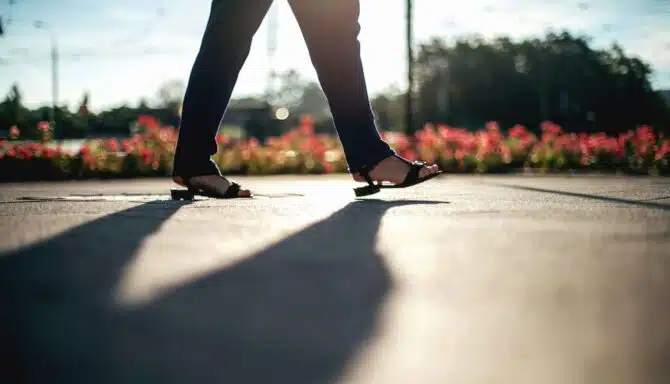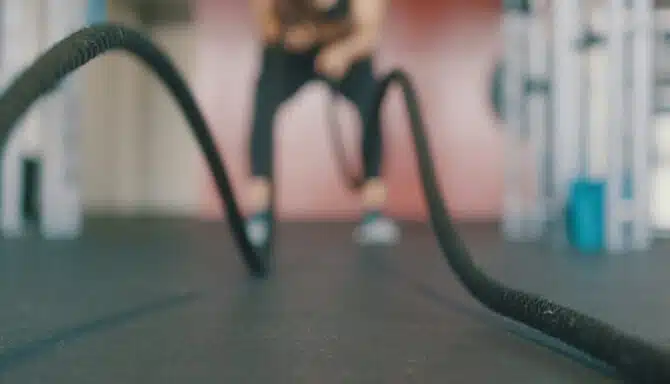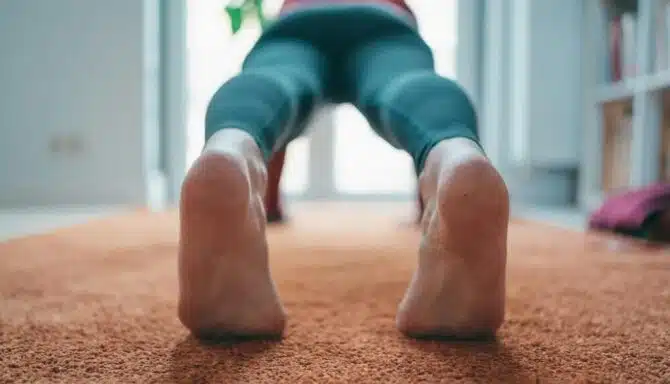July 8, 2024
Shock absorption sounds like a superpower! But it’s actually a term describing how our shoes provide impact protection from the ground, floors and pavement. This benefits our foot health, but it also begins the upward “chain of command” of protecting the joints, bones and muscles in our knees, back and legs. Shock absorption in shoes typically involves innovative footwear technology and high-quality shoe design. Let’s review everything you need to know about this fascinating topic!
The Science Behind Shock Absorption in Shoes
You may be familiar with how cars have pump-like systems called shock absorbers, which dampen impulses from driving on the pavement. Your shoes are similar, but the physics are a little different!
Shoes with a good amount of shock absorption may include the following components:
Solid shoe cushioning in the insole, often made from gel, foam, etc.
Midsoles made from comfortable and sometimes dense materials, like EVA foam. These midsoles are often able to compress and then return to their original shape during movement.
Durable outsoles, made from materials like rubber.
Extra heel cushioning for heel striking.
These features work together to protect your feet from developing musculoskeletal foot conditions, which include but aren't limited to:
Plantar fasciitis
Heel spurs
Metatarsalgia
Different types of arthritis
Achilles Tendonitis
Think about it this way: nobody wants to walk a mile in flip flops! There would be virtually nothing in between the bottom of your foot and the ground’s surface, and you would feel fatigue, pain and overall discomfort afterwards. The longer you ignore foot support and shock absorption, the more wear and tear you will sustain!
And this affects more than just your feet — your entire body feels the impact. The pain starts at the foundation, your feet, but it will trickle upward to other body parts (knees, back, etc) since your muscles, ligaments, tendons and bones are all connected to ensure our body moves efficiently and with stability.
Who Needs Shock Absorption The Most?
Athletes, especially runners, benefit from shock absorption. With each stride, they are hitting the pavement, trails and floors harder than anyone else. They need high-quality athletic footwear that retains most of its shock absorbing abilities after long-term use.
But it’s not just all-star athletes. Everyday folks enjoying an outdoor walk in downtown Toronto; the longer the walk the more shock absorption you'll need. People with disabilities like severe arthritis or those with foot conditions like bunions or hammertoes, to name a few, should also be mindful of the grounds impact on the feet and body.
A Final Note on Shock Absorption
Shock absorption can be a balancing act. Sometimes “less is more" and you want to be careful of completely eliminating the “ground feel.”
For example, overly cushioned shoes and a very elevated outsole might not be right for people with mobility challenges or those who need walking shoes instead of running shoes. Both can lead to instability and a heightened risk of sustaining a foot injury.
Athletes should also be careful. Sometimes, too soft or too thick soles can affect sensory feedback and lead to a fall.
June 3, 2024
Do orthopedic shoes have their place in fashion? The answer is yes! While there is no doubt orthopedic shoes are designed to treat foot conditions, it doesn’t exclude them from contemporary 2024 shoe trends. Let’s review the top choices for stylish orthopedic shoes this year!
Stylish Orthopedic Footwear 2024
Orthopedic shoes usually have specific features, such as:
Built-in arch support for plantar fasciitis, etc.
Extra cushioning / shock absorption (protects your joints from the impact of the ground!)
A wide toe box for foot deformities like bunions, hammertoes, etc.
Removable insoles to give you the option of using orthotics.
A firm heel counter for proper stability or motion control.
Adjustable straps to accommodate edema (swelling) and for a snug, breathable fit.
That’s a lot to look for! And it’s a common misconception that these features look unappealing. The truth is, you can't often see these features at first glance; orthopedic shoes do not have to look clunky.
If you’re not sure where to look for comfortable and fashionable shoes, keep reading for some examples that offer the best of both worlds. The cherry on top? All of them are available at Feet First Clinic!
Anodyne No. 27
Anodyne No. 27
Anodyne shoes are designed to help treat diabetes-related foot problems and other musculoskeletal issues and deformities. The No. 27 is a simplistic white walking shoe that pairs perfectly with casual attire. Features include a rigid heel counter to help with instability, a protective toe box, a supportive sole, and more. It's a comforting staple that keeps modern fashion trends in mind!
APEX Logan Chelsea Boot
The Logan Chelsea Boot from APEX offers a good amount of depth, and a removable EVA insole to boot (no pun intended!). The side zipper and lack of laces makes it easier for people with mobility challenges to get their feet in and out. This boot is also perfect for every season, from spring all the way to winter!
APEX LOGAN CHELSEA BOOT
Aetrex Men's Milos And Women's Jess
Aetrex is a cutting edge company offering trendy orthopedic shoes. The men's Milos are an orthopaedic slide sandal that combines the comforting and supportive features you would typically find with a custom orthotic, with the breathability and stylish flair of a summer sandal. They're super durable and have great arch support and cushioning thanks to UltraSky™ EVA technology.
Like the Milos, the Jess from Aetrex is another sandal offering the same top-of-the-line arch support and cushioning. The microfibre top cover adds a layer of softness and fights against cuts, scrapes and blisters. One minor difference is the easily adjustable ankle strap for extra ankle support.
NAOT Amadora
Looking for a fashion-forward sandal with a slight platform and fun design? The NAOT Amadora is a great finishing touch for your everyday summer dresses, skirts, and more! The hook and loop strap with full upper coverage is great for those who prefer a more secure feel to their sandals. The removable, anatomic cork and latex footbed conforms to the natural shape of your foot as it moves, offering maximum comfort! The best part: the footbed is removeable so you can wear them with your custom orthotics!
Naot Amadora
May 20, 2024
As the temperatures rise and the sun shines brighter, it's time to ditch the closed-toe shoes and slide into something more comfortable and breathable. Yes, it's sandal season! But with so many options available, how do you choose the best sandals for your summer adventures? We've got you covered.
In this guide, we'll explore the essential features to look for in summer sandals and introduce you to some top picks that seamlessly blend style with comfort.
Cork footbed
One key feature to consider when selecting summer sandals is the footbed material. Cork footbeds are famous for their ability to mould to the shape of your foot over time, providing personalized support and cushioning.
Additionally, cork is lightweight and absorbs shock, making it an excellent option for all-day wear. Whether strolling along the boardwalk or exploring a new city, sandals with cork footbeds ensure your feet stay comfortable and supported.
Arch support
Arch support is essential, especially if you plan on wearing your sandals for extended periods. It distributes weight across your feet, reducing strain and preventing discomfort. A lack of arch and forefoot support can lead to foot problems like plantar fasciitis or metatarsalgia.
Look for sandals with arch support or removable insoles. You can customize the level of support to your liking. Your feet will thank you after a long day of sightseeing or outdoor activities.
Backstraps for support
While slip-on sandals are convenient, they may provide a different level of support and stability than those with backstraps.
Backstraps help secure the sandals to your feet, preventing them from slipping and sliding with each step. Added stability is particularly beneficial if you plan to engage in more active pursuits or tend to pronate or supinate. Backstraps come in various styles, from adjustable buckles to elasticized bands, allowing you to find the perfect fit for your feet.
Our top picks
Now that we've covered the essential features to look for in summer sandals let's introduce you to some top picks that effortlessly combine style with comfort.
NAOT Cornet and NAOT Castelo
Best for cork footbeds
With their contoured cork footbeds and adjustable backstraps, NAOT sandals offer exceptional comfort and support. The NAOT Cornet and NAOT Castelo styles feature chic designs that transition seamlessly from day to night.
Mephisto Hester and Mephisto Hetty
Best for cork footbeds
Mephisto sandals are renowned for their superior craftsmanship and comfort technology. The Mephisto Hester and Mephisto Hetty models boast cushioned footbeds with arch support and durable backstraps for added stability.
Aetrex Jess
Best for arch support
The Aetrex Jess sandals feature a built-in Lynco orthotic footbed for maximum support and alignment. The adjustable backstrap ensures a secure fit, making them ideal for all-day wear.
NAOT Enid and NAOT Amadora
Best for backstrap support
NAOT offers a range of stylish sandals with cork footbeds and backstrap designs. The NAOT Enid and NAOT Amadora are built with quality and comfort in mind. The three variations three are perfect for summer adventures.
Mephisto Norine
Best for backstrap support
The Mephisto Norrine sandals combine elegance with functionality. Featuring Soft-Air technology and adjustable straps, they provide unparalleled comfort and support for any occasion.
May 16, 2024
Top-notch athletic foot health is key, especially when summer rolls around. Your activity level changes in the summer when you start spending more time outdoors pounding the pavement in the sun. To make sure your feet don't hold you back from your summer plans, here are our top summer sports foot care tips for healthy feet.
Preventing Summer Sports Injuries in Athletes
When it comes to foot care and sports, the right footwear and healthy exercises/stretches are always a winning combo. Below you’ll find the most common strain-related summer sports injuries and what you can do to stay on your feet!
Achilles Tendonitis
Avoid straining the Achilles tendon by gradually increasing activity intensity. For example, run shorter distances while working your way up to longer journeys.
Stretch the calf muscles / Achilles tendon every day. Try the calf exercises in this article. Also make sure you stretch your soleus muscle too!
Wear runners with an elevated heel, turned-up toe and rocker soles. (Learn more about rocker soles here.)
Ankle Sprains
Wear athletic shoes with stong ankle support while playing sports like basketball and volleyball. Shoes with wider soles can help too.
If you’re prone to sprains or tend to overpronate when you walk, try stability shoes.
Strengthen your ankles with these exercises.
Stress Fractures
Stability and motion control shoes with a more rigid design and thick soles are good for runners who may be prone to stress fractures.
Gradually increase activity intensity to avoid hurting yourself, especially if you have been on hiatus!
To avoid stress fractures while strength training or weight lifting, wear a shoe with a wider toe box, a hard/thick sole and a minimum level of cushioning.
Plantar Fasciitis
Wear the best shoes for plantar fasciitis. These tend to be stability shoes, but neutral can also work. The key thing is to look for shoes with sufficient arch support.
Perform strengthening and preventative stretches that target the plantar fascia. These include calf stretches, towel stretches, and more that you can find here.
Runner’s Knee (Patellofemoral Pain Syndrome)
Prevent knee pain by strength training, paying close attention to the quadriceps and hip muscles.
Avoid shoes with a raised heel, as they can place too much pressure on the knee joint.
There should be a medium amount of cushioning in shoes; too much can cause knee instability.
Foot Care Tips for Preventing All Injuries
Footwear should always be well-fitted and supportive, regardless of what injury you're trying to prevent.
Certain features can help defend against specific injuries, but shoes must always fit properly, leaving enough room for the foot to position itself and for the toes to spread. Shoes must also always have some level cushioning and support. Lightweight shoes tend to be beneficial for athletes when competing so they can propel forward more effortlessly. Additionally, athletes should always wear running shoes with good shock absorption; it acts as a barrier between your joints and the impact from the ground.
You can also boost your protection with custom orthotics or Superfeet insoles. These offer extra support for your feet and joints.
Preventing Skin Conditions in Athletes
One of the most infamous skin issues athletes face in the summertime are blisters. Running outside in the hot sun can cause increased friction and moisture buildup in your shoe environment. Even though most blisters go away on their own, competitive runners and racers can sometimes face serious blister complications like intense pain, sepsis, and cellulitis.
Ensure your footwear fits well so your skin isn’t rubbing harshly against your shoes. To tackle the moisture problem, try sweat-wicking socks and foot deodorants, which come as sprays, powders and creams (these can also help with foot odour and athlete's foot prevention). Medical devices like custom orthotics, insoles and blister pads can also help place feet in the best position for preventing blisters.
May 2, 2024
Whether you're hitting the gym, running, or attending a fitness class, proper footwear is essential for optimizing performance, preventing injuries, and ensuring comfort throughout your workout. With so many options available, choosing the right shoes can be overwhelming. In this blog post, we'll break down the critical considerations for selecting the perfect pair of shoes for your specific workout needs, so you step confidently into your fitness journey.
Understanding your feet
Before making shoe selections, understand your feet and movement patterns. Consider factors such as foot shape, arch type, pronation (how your foot rolls inward), and activities you engage in. For example, those with flat feet may require extra arch support, while individuals with high arches may benefit from cushioned shoes to absorb shock.
Key factors for working out
Running
Choosing the right shoes for running is essential to preventing injuries and enhancing performance. Look for running shoes that provide ample cushioning to absorb impact and support to promote proper alignment. Consider factors such as your running gait, terrain, and distance when selecting shoes, and opt for models designed specifically for road running, trail running, or racing, depending on your needs.
Cross-training
For cross-training activities such as weightlifting, HIIT (high-intensity interval training), and circuit training, opt for versatile shoes that offer stability, support, and flexibility. Look for shoes with a flat sole and firm heel to provide a solid base for lifting weights and enough cushioning to support dynamic movements like jumps and lunges.
Walking
Whether walking for exercise or daily activities, selecting the right shoes is essential for comfort and support. Look for shoes with cushioned midsoles, supportive arches, and durable outsoles to provide shock absorption, stability, and traction. Consider breathable uppers and moisture-wicking linings to keep your feet cool and dry on longer walks.
Other sports
Choose shoes designed for specific sports, such as tennis, basketball, or soccer, to meet the unique demands of each activity. Look for shoes with lateral support for quick cuts and pivots, ankle support to prevent sprains, and durable outsoles for traction on court surfaces.
Additional tips for footwear selection
Try shoes in the afternoon or evening when your feet are slightly larger.
Wear the socks you typically wear during workouts to ensure the right fit.
Test the shoes by walking, jogging, or performing movements similar to your workout routine to assess comfort and support.
Replace worn-out shoes regularly to maintain optimal performance and prevent injuries. For runners, shoes typically wear out around 800 kilometres.
April 29, 2024
Heel pain is a common complaint affecting individuals of all ages and lifestyles, from athletes to office workers. It can be frustrating and debilitating, whether it's caused by plantar fasciitis, heel spurs, or Achilles tendonitis. Fortunately, you can take steps to prevent heel pain and keep your feet happy and healthy.
This blog post explores practical tips and exercises for preventing heel pain and maintaining optimal foot health.
Causes of heel pain
Before diving into prevention strategies, it's essential to understand the common causes of heel pain. Plantar fasciitis, the inflammation of the band of tissue that runs along the bottom of the foot, is one of the leading causes of heel pain. Other culprits include:
Heel spurs
Bony growths on the heel bone
Achilles tendonitis
Inflammation of the Achilles tendon at the back of the heel
Factors such as improper footwear, overuse, obesity, and poor foot mechanics can contribute to the development of heel pain.
Heel pain prevention tips
Choose supportive footwear. Invest in shoes that provide adequate arch support, cushioning, and stability. Look for options with a slightly elevated heel to reduce strain on the Achilles tendon and plantar fascia.
Maintain a healthy weight. Excess weight can put added pressure on the feet and exacerbate heel pain. Maintain a healthy weight through a balanced diet and regular exercise to reduce the risk of developing heel pain.
Gradually increase activity. Avoid sudden increases in physical activity, such as jumping into a rigorous exercise routine or increasing mileage too quickly. Gradually increase activity levels to allow your feet time to adapt and prevent overuse injuries.
Stretch regularly. Incorporate stretching exercises into your daily routine to improve flexibility and prevent tightness in the calf muscles and Achilles tendon. Focus on stretching the calves, hamstrings, and plantar fascia to alleviate tension and reduce heel strain.
Practice good foot mechanics. Pay attention to your foot mechanics when walking, running, or participating in sports. Avoid overpronation or excessive rolling inward of the feet, as this can strain the plantar fascia and Achilles tendon.
Heel pain exercises
Calf stretch. Stand facing a wall with one foot in front of the other, keeping the back leg straight and the heel on the ground. Lean forward, bending the front knee until you feel a stretch in the calf of the back leg. Hold for 30 seconds, then switch sides.
Plantar fascia stretch. Sit on the floor with one leg extended before you. Loop a towel around the foot and gently pull the toes towards you until you feel a stretch along the bottom of the foot. Hold for 30 seconds, then switch sides.
Achilles tendon stretch. Stand facing a wall with one foot in front of the other. Place your hands on the wall at shoulder height and lean forward, bending the front knee until you feel a stretch in the back of the lower leg. Hold for 30 seconds, then switch sides.
Heel pain can be debilitating and impact daily activities and quality of life. Incorporating these prevention tips and exercises into your routine can reduce the risk of developing heel pain and keep your feet healthy and pain-free. Remember to listen to your body and seek professional medical attention if you experience persistent or severe heel pain.






